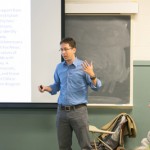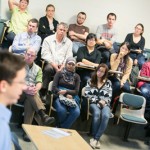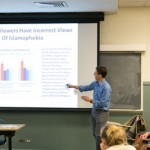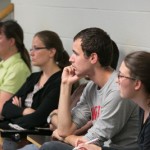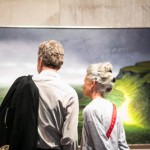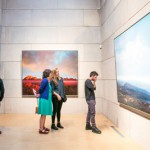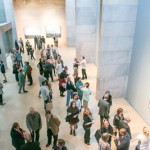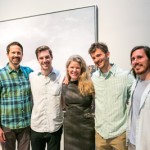Eli Clifton, co-author of the Center for American Progress’ groundbreaking report Fear, Inc., described the investigative tools he used to help reveal the nexus of politicians, professional Islamophobes, and big money special interests who have fueled the spike in Islamophobia in the United States in “Big Data Investigative Journalism: How Public Documents and the Internet Helped Map the Islamophobia Industry.” The discussion was held on Thursday, October 2, 2014, at the Public Affairs Center. Images by Sandy Aldieri of Perceptions Photography. Click here to view the full album on flickr.
Art & Art History
Fall Photos: Opening Reception – A World of Dreams: New Landscape Paintings by Tula Telfair
Professor of Art Tula Telfair’s A World of Dreams exhibition of new large-scale paintings presenting monumental landscapes and epic-scale vistas that are simultaneously awe-inspiring and intimate, runs through December 7, 2014. Photos from the opening reception on Tuesday, September 16, 2014, in the Main Gallery of the Ezra and Cecile Zilkha Gallery. Images by Sandy Aldieri of Perceptions Photography. Click here to view the full album on flickr.
2014-15 Season Now On Sale! World, U.S., New England, CT Premieres
This year, we invite you to join us as we welcome the world to Wesleyan. Artists working in contemporary or traditional forms from 18 different countries will be performing or exhibiting at the CFA over the next nine months.
 A centerpiece of this year’s program is Muslim Women’s Voices at Wesleyan, which begins in September. Each of the performers to be featured is Muslim or of Muslim heritage, has a distinct set of personal experiences, and is embedded in a particular place, society, and cultural tradition. It is our way of inviting audiences to celebrate the complexity of Muslim women today, while at the same time exploring the historical and cultural context from which these women have emerged. We are also inviting audiences to participate in the creative process as we give birth to a new play by Leila Buck ’99, based on stories of Muslim and Muslim-American women in our region.
A centerpiece of this year’s program is Muslim Women’s Voices at Wesleyan, which begins in September. Each of the performers to be featured is Muslim or of Muslim heritage, has a distinct set of personal experiences, and is embedded in a particular place, society, and cultural tradition. It is our way of inviting audiences to celebrate the complexity of Muslim women today, while at the same time exploring the historical and cultural context from which these women have emerged. We are also inviting audiences to participate in the creative process as we give birth to a new play by Leila Buck ’99, based on stories of Muslim and Muslim-American women in our region.
We are also bringing one of the United States’ most innovative theater companies working at the intersection of text and technology, The Builders Association, for two performances in October. Their amazing production Sontag: Reborn is a portrait of the younger years of one of America’s most iconic intellectuals, Susan Sontag. In November, the Theater and Music Departments join forces to mount the Tony Award-winning musical In the Heights, directed by Theater’s Cláudia Tatinge Nascimento with music direction by Nadya Potemkina, director of the Wesleyan University Orchestra. The musical was the thesis production of Lin-Manuel Miranda, a Theater major who graduated in ’02, who went on to win the Tony for “Best Original Score.” The book was written by Quiara Alegría Hudes, winner of the Pulitzer Prize, who will be a visiting faculty member at Wesleyan this year. It is sure to be an extraordinary production. And throughout the fall, the epic-scale, haunting landscape paintings of Professor of Art Tula Telfair will be on view in Zilkha Gallery. We invite you to enter into the imaginary worlds that Telfair creates in twelve large-scale paintings that are simultaneously awe-inspiring and intimate.
We launched our new website over the summer, and we hope you’ll visit and return often to find out about all of the faculty, student, and visiting artist events and exhibitions this year. We hope you will look to us as a place of enlightenment and enjoyment in the coming months.
Pamela Tatge
Director
Center for the Arts
“Summer at the CFA” to include world premiere jazz; Connecticut premiere dance
Summer at the CFA
July 1-20, 2014
 EVENING PERFORMANCES
EVENING PERFORMANCES
1. Zili Misik – Wednesday, July 2, 7pm, CFA Courtyard (Rain Location: Crowell Concert Hall), FREE!
2. Camille A. Brown & Dancers – Friday, July 11, 8pm, CFA Theater (Connecticut Premiere)
3. Joe Lovano Trio Fascination with special guest vocalist Judi Silvano – Thursday, July 17, 8pm, Crowell Concert Hall (World Premiere)
FREE AFTERNOON TALKS AND PERFORMANCES
4. Banning Eyre: Tales from the Afropop Road – Bringing the World to American Public Radio – Tuesday, July 1, 12:10pm, CFA Hall, FREE!
5. James Grashow: Art and Cardboard – Tuesday, July 8, 12:10pm, CFA Hall, FREE!
6. Aaron Jafferis: How to Change the World with Hip-Hop Theater – Tuesday, July 15, 12:10pm, World Music Hall, FREE!
7. This is It! The Complete Piano Works of Neely Bruce: Part III – Sunday, July 20, 3pm, Crowell Concert Hall, FREE!
Tickets for Camille A. Brown & Dancers and Joe Lovano Trio Fascination with special guest vocalist Judi Silvano are on sale now online!
Center for the Arts Stories: Karen Kawaguchi ’75
Center for the Arts Story: When I arrived on campus in 1971, the Center for the Arts was still an architect’s concept, and arts/music/theater/film/dance people made do with classrooms, studios, and performance spaces, scattered all over campus. So what a miracle when the CFA doors opened, giving us access to magnificent galleries, theaters, the auditorium, studio and practice spaces. As a music major (piano), it was a thrill to practice on grand pianos in the soundproofed practice rooms. Though I never became a professional musician, Wesleyan and the CFA planted the seeds for a lifelong passion for the arts. In February, I went to the Metropolitan Museum of Art and saw the work of Piero de la Francesca, Fra Angelico, and other Renaissance masters, remembering how John Paoletti’s brilliant teaching awakened my love of art of that period. Attending Wes concerts, from early music to gamelan, gave me a taste for musical adventures, and I continue to explore and relish an eclectic range of performances in New York City. A couple of years ago, I was lucky to catch Ralph Samuelson MA ’71 (Ethnomusicology), performing with Japanese shakuhachi master Kinya Sogawa at Roulette in Brooklyn.
Favorite Course: Italian Renaissance art
Favorite Professor: John Paoletti
Three Different Capstones to the Wesleyan Experience (May 1)
CFA Arts Administration Intern Chloe Jones ’15 talks to graduate student Samuel Dickey ’14, and seniors Daniel Light ’14 and Emmie Finckel ‘14 about their capstone projects.
Wesleyan’s Center for the Arts offers undergraduate programs in Art & Art History, Dance, Music, and Theater, and graduate programs in Music. In every department, students have the opportunity to create a capstone project in their final year. These projects take myriad forms, each one a reflection of the student’s unique interests and creative voice.
On Thursday, May 1, 2014 at 9pm in Crowell Concert Hall, graduate student in music Samuel Dickey ’14 will present his thesis concert. After graduating from the Berklee College of Music in Boston, Mr. Dickey came to Wesleyan in pursuit of a Master of Arts degree in Ethnomusicology.
The two-year program does not require that students produce a concert, as not all ethnomusicologists play an instrument. Mr. Dickey, however, picked up his first guitar at the age of ten and hasn’t stopped playing since. In 2010 he learned to play the Jeli Ngoni, a string instrument from West Africa.
His thesis concert brings together musicians from the Wesleyan community and beyond, including a couple of his bandmates from New York City. Half of the performers are Wesleyan students.
In addition to the recital, Mr. Dickey’s thesis includes a written component of 75 pages. His essay examines the role of the guitar in West African music, and how this once foreign instrument became integrated into the performance of traditional songs. He is looking specifically at music produced on either side of the border between Mali and Guinea.
“Guitars have become a vehicle for translating traditional music into a more popular sphere,” he explains. “But more than the music being westernized by the guitar; the guitar has been Africanized by the music.”
Together, the essay and his recital mark the culmination of his studies at Wesleyan.
“The master’s program has been great,” says Mr. Dickey. “I think it will allow me to pursue the sort of foothold I’ve been after in the music world.”
After graduation Mr. Dickey hopes to attain an ensemble coaching position or become an artist-in-residence.
In addition to graduate students, many undergraduates in the Music Department produce recitals as their senior capstone projects. One such undergraduate is Daniel Light ’14, whose senior recital Resonance took place on Friday, April 18, 2014 in World Music Hall.
The Music Department grants its undergraduate majors a lot of flexibility in designing their senior projects. One student may choose to record an album, while another opts for making a musical.
Mr. Light began with a couple of songs that he had written and ultimately developed a set list of seven original numbers. He performed four of the songs with a full band, one with a string trio, one with a choral group, and one as a solo.
“It felt like a launching point,” reflects Mr. Light. “I remember thinking that I would like to do this again at some point, to use my own material to fuel a concert.”
Much like students in the Music Department, those majoring in Theater have the leeway to design a senior capstone project tailored to their interests. This past November, as part of her thesis, Emmie Finckel ‘14 designed the set for the Theater Department’s production of Anton Chekhov’s The Seagull.

Envisioned as a theater prop house gone to ruin, the set filled the enormous stage in the CFA Theater with furniture and other objects. The audience watched the performance from the stage, immersed in the set alongside the actors.
The hands-on work that Ms. Finckel did for The Seagull comprised the first part of her thesis. The second part is an essay of 30 to 40 pages, in which she examines audience agency in immersive theater design.
Ms. Finckel’s thesis gave her the opportunity to work closely with faculty members, including Associate Professor of Theater Yuri Kordonsky, who directed the production, and Assistant Professor of Theater Marcela Oteíza, who has become a mentor to Ms. Finckel in her time at Wesleyan.
“It was wonderful to feel like they respected me enough to want me to be involved [in The Seagull] as their collaborator,” recalls Ms. Finckel.
Dramatically different in approach and content, these three examples of capstone projects speak to the wide-reaching interests of Wesleyan students and their impulse to innovate and create. The capstone programs provide students an opportunity to synthesize the experiences that they’ve had at Wesleyan, reflecting both on where they’ve been and where they can go.
Center for the Arts Stories: Harold Sogard ’74

Center for the Arts Story: I was a senior theater major when the Center for the Arts opened in 1973. I’ve never put much stock in things supernatural, but there was always something freaky to me about the fact that the stage of the new theater was located on the exact spot where my grandparents had once had their house and where my mother had been born. I spent hundreds of fantastic, life-changing hours in the CFA. Before it even opened, I earned some much needed cash during the summer of ’73 working as a carpenter there, building things like the speakers in the new cinema and the cabinets in the design studio of the new theater. As a theater major, I took classes there, ran the (then revolutionary) new computer light board for the first play in the new theater, and I played the Referee in Fritz DeBoer’s production of Sam Shepard’s The Tooth of Crime. As President of WESU-FM, I produced a series of broadcasts of inaugural concerts from various venues, including an all-night-long gamelan concert and shadow puppet performance from the World Music Hall. And as a typical student attending CFA concerts, performances, exhibitions, and lectures, I had my eyes and ears and mind opened for a lifetime to a broad range of artistic expressions.
Favorite Course: Directing for the Stage
Favorite Professor: Ralph Pendleton
Thesis Title: “An Exploration of Simultaneity as a Form for the Theatre”
Center for the Arts Stories: John Spike ’73

Favorite Course: Art History 101
Favorite Professors: Samuel Green & Heinrich Schwarz
Center for the Arts Story: Work began on the Center for the Arts while I was an undergrad. We never saw any part of it finished, but, in keeping with Wesleyan’s penchant for the exotic and barely practical, we felt proud that it was projected to have an entire building dedicated to just the gamelan orchestra. My professor and advisor in Art History was the beloved Sam Green, who painted in a traditional realism style but favored all things modern. Sam was instrumental in securing approval for Kevin Roche’s modernist-brutalist plan for the CFA. We all had some concern about what we had wrought as the massive monolithic temple blocks were lined up in the woods, and the joke on campus was, “It looks like something designed for the Mayans but rejected by them.”
“Evan Roth//Intellectual Property Donor” in Zilkha Gallery through March 2
CFA Arts Administration Intern Chloe Jones ’15 talks to Virgil Taylor ’15, Sewon Kang ’14, and Stratton Coffman ’14 about the exhibition “Evan Roth//Intellectual Property Donor,” on display in the Ezra and Cecile Zilkha Gallery through Sunday, March 2, 2014. Admission to the gallery is free.

On display now in the Ezra and Cecile Zilkha Gallery is the exhibition Evan Roth//Intellectual Property Donor. This is the largest one-man show to take place in the United States for the Paris-based American artist.
Blurring the line between artist and hacker, the exhibition asks gallery visitors to consider how everyday life intersects with virtual reality and how viral media can become high art.
Beautiful, curving, white sculptures are suspended from the gallery ceiling, each one algorithmically produced from motion-tracked graffiti data. Across the gallery, an interactive installation invites visitors to create their own TED talks on a stage that looks startlingly identical to the TED stage. Covering one wall is a series of 1,540 smartphone screen-sized ink prints depicting the gestures required to beat all 300 levels of the popular game “Angry Birds.”
With an interest in the overlap between free culture and popular culture, Roth transforms existing systems into public, often political, statements. As part of the exhibition, visitors can obtain a small sticker that reads: “In the event of death please donate all intellectual property to the public domain.” Perfect for the back of your driver’s license, he wryly suggests.
Roth was on campus for a week leading up to the opening reception on the evening of Wednesday, February 5, 2014. I spoke with three Wesleyan students who had the opportunity to work directly with him during that time.
Studio Art major Virgil Taylor ‘15 first met Roth when the artist visited Wesleyan last year. Intrigued by his work, Taylor signed up to help with the Evan Roth//Intellectual Property Donor exhibition and returned to campus early from winter break in order to begin preparing for the show’s opening.
One work in the exhibition, Propulsion Painting, consists of a variety of mixed-media sculptures that use the pressure within spray paint cans to perform tasks such as the one in this video.
Roth needed 70 empty spray paint cans! Taylor emptied what cans he could by repainting all the stools in two classrooms, and spent the rest making a series of paintings. Done on canvases typically used in the installation of exhibitions, the series was titled In Conjunction and displayed in South Gallery next door to the Evan Roth//Intellectual Property Donor exhibition on opening night.
“It ended up being a really productive experience and a really great exercise for me,” says Taylor, who had never worked with spray paint before. Taylor also attended a daylong workshop held by Roth on the topic of hacking culture, in which students made mini projects based on systems they observed in their surroundings. “It was a really fast process: talk about it, identify a system, do something,” Taylor describes.
Here is an artist interested in talking about ideas, observing the world, and then acting. The internet, Roth argues, is not only a means of communication but also a rich artistic medium and a potent vehicle for activism.
Creative Campus Intern Sewon Kang ’14 also attended the workshop. According to her, “Evan works with infrastructure that is already there for him to subvert, so when he talks about activism he talks about how activists don’t necessarily need to go in and build from the ground up.”
Roth’s activism takes place through creativity and innovation, always seeking to make small interventions that will attract worldwide attention.
“There are already systems in place that you can change to work to your advantage,” explains Kang. “Roth sees everything in the world as an opportunity. Where I see a room full of tables and chairs, he sees the tables and chairs as a system for some sort of intervention.”
Zilkha Intern Stratton Coffman ’14 also spoke about the activist impulse running through Roth’s work. “He’s asking, in what ways can we exploit the technological and social systems that are already there to change not only our environments, but also what it means to be an agent in the world.”
Coffman was first introduced to Roth’s work last year when the proposal to bring Evan Roth//Intellectual Property Donor to Wesleyan came before the Zilkha Planning Committee.
“I was intrigued,” Coffman remembers. “What’s alluring about his work is its interconnectedness. It’s part of a larger practice, each individual work, which makes them all more complex.”
Having followed Roth’s journey to Wesleyan and interacted with him and his work on numerous different occasions, Coffman says, “There are still interesting questions to think about, which is partly why I think it’s such a fruitful show. There are these questions in the works that are not resolved.”
Evan Roth//Intellectual Property Donor is more than an art exhibition, it is a catalyst for creative thinking and a commentary on our world, a call to action and an interactive sensory feast.
The exhibition will be open through Sunday, March 2, 2014 at 5pm. Visit the exhibition website for more information, photos, and the video of the artist talk that Roth gave on the night of the opening.


